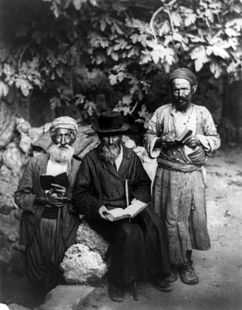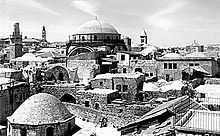Judah HeHasid (Jerusalem)
- See Judah he-Hasid for other people who used this name.
| Old Yishuv |
|---|
 Jewish life in the Land of Israel |
| Key events |
|
| Key figures |
|
| Economy |
| Philanthropy |
|
| Communities |
|
| Synagogues |
| Related articles |
Judah he-Hasid Segal ha-Levi[1] (Hebrew: יהודה החסיד Yehudah he-Hasid, "Judah the Pious"; ca. 1660, Siedlce – October 17, 1700, Jerusalem, Ottoman Syria) was a Jewish preacher who led the largest organized group of Jewish immigrants to the Land of Israel in the 17th and 18th centuries.
Departure from Europe
Judah traveled from one Jewish community to another throughout Poland, urging repentance, ascetism, physical mortifications, and calling for aliyah.
In 1697, he and 31 families of his followers left for Moravia and made a stop at Nikolsburg. Judah spent a year traveling throughout Germany and Moravia gaining followers. Many joined the group, influenced by his fervor. By the time the whole group gathered in Italy, they numbered about 1,500.
Almost a third of the pilgrims died of hardships and illnesses during the trip. On the way, they contracted debts, and in exchange for permission to enter the Ottoman Empire they were forced to give the Turkish authorities financial guarantees in the name of Jerusalem's Jewish community.
Arrival in Jerusalem
The group arrived in Jerusalem on October 14, 1700. At that time, about 200 Ashkenazi and about 1,000 Sephardi Jews lived in the city, mostly on charities from the Jewish diaspora. The sudden influx of between 500 to 1,000 Ashkenazim [2] produced a crisis: the local community was unable to help such a large group. In addition, some of the newcomers were suspected to be Sabbateans,[3] whom the local Jews viewed with hostility. The situation grew worse when Judah He-Hasid died within days of his arrival to Jerusalem. He is buried on the Mount of Olives.
Emissaries were sent to the Council of the Four Lands for aid, but it didn't arrive.
Ban on Ashkenazim
The newcomers went deeper into debt to build a small synagogue. In 1720, Arab creditors broke into the synagogue, set it on fire, and took over the area.
The Turkish authorities blamed all Ashkenazi Jews for the mess, refused to make a distinction between the old Jerusalem community and the newcomers, held them collectively responsible for the debts, and banned all Ashkenazim from the area.
Legacy

Some of the Ashkenazi Jews moved to other cities (mainly Jewish holy cities other than Jerusalem: Hebron, Tiberias, and Safed). Others started to dress like Sephardi Jews.
The synagogue, called Hurvat Yehudah He-Hasid (Destroyed Place of Judah He-Hasid), was rebuilt in 1864 by the Perushim, becoming the chief Ashkenazi synagogue in Jerusalem. The building was destroyed by the Arab Legion in 1948. It was then rebuilt and rededicated in 2010.
References
- ↑ Folktales of the Jews: Tales from the Sephardic dispersion p. 38
- ↑ Sources vary on the number:The Churva, by Dovid Rossoff puts the number at "over 500"; others put it at 1000.
- ↑ Aviezer Ravitzky. Messianism, Zionism, and Jewish religious radicalism. 1996, page 228
External links
- The Land of Promise: The Return to Zion March 27, 2003 (Israel MFA)
- Pre-Zionism (Jewish Agency for Israel)